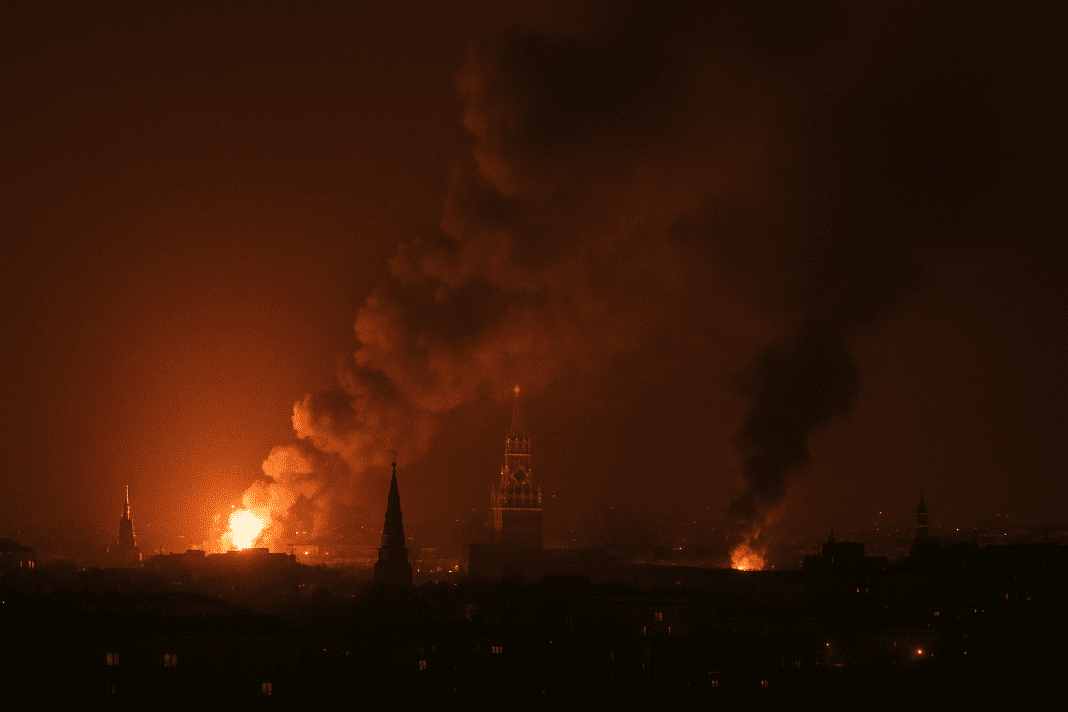A series of explosions rocked the Russian capital late on Sunday, October 26, as unidentified drones targeted several areas across Moscow. Witnesses reported loud detonations and visible plumes of smoke rising from multiple districts, prompting panic among residents and disrupting evening activities across the city.
Drones Strike Moscow Amid Rising Tension
According to reports shared by Andriy Kovalenko, head of Ukraine’s Center for Counteracting Disinformation, Moscow came under an unexpected drone attack late Sunday evening. Kovalenko confirmed that explosions were being heard in the city, though he did not provide details on the number of drones or the specific locations affected.
Russian state-controlled media released images and videos showing flashes in the night sky, thick smoke, and emergency response vehicles rushing to affected areas. In several Moscow neighborhoods, residents said their buildings shook as air defense systems opened fire overhead. Social media channels quickly filled with footage of tracer rounds streaking across the sky and the echo of distant blasts.
Russian authorities issued a brief statement assuring citizens that the country’s air defense systems had intercepted all incoming drones. However, conflicting reports from local residents suggested otherwise, with at least one high-rise building reportedly struck. Several Moscow-based Telegram channels claimed that debris from downed drones caused fires on rooftops and in parking areas.
War by algorithm: Ukraine turns to drones and data to counter Russia’s military machine
Officials Downplay the Incident as Residents Panic
Moscow Mayor Sergey Sobyanin stated that “air defenses successfully repelled several drone attacks over the capital,” adding that emergency services were deployed to inspect potential damage. Sobyanin did not mention the plumes of smoke seen rising over northern and eastern Moscow or the sirens that reportedly sounded near central districts.
Videos circulating online showed smoke drifting above the city skyline, including areas not far from the Kremlin. Some residents described hearing “a loud, metallic explosion” followed by smaller blasts, while others said air raid alarms briefly sounded before being switched off.
Russian authorities have repeatedly emphasized that the situation is under control, but panic spread rapidly through community chat groups and online forums. Several residents were seen leaving high-rise buildings and gathering outside, fearing secondary explosions. Public transport operations were briefly disrupted in parts of the capital, and reports suggested that flights from Moscow’s Vnukovo and Sheremetyevo airports experienced temporary delays.
Eyewitnesses described the atmosphere as tense, with police cordoning off several streets while emergency crews examined debris. A resident in the Khoroshevo-Mnevniki district told local media, “The explosions were very loud—first one, then another after a few seconds. The ground shook, and car alarms went off everywhere.”
Conflicting Claims and Expanding Strikes
Russian Telegram channels, many aligned with pro-Kremlin sources, claimed that the drones originated from Ukrainian territory and were aimed at key military facilities. One channel alleged that a Ukrainian drone hit a high-rise residential complex. However, analysts and independent observers noted that such damage might have been caused by Russian air defense missiles misfiring—a scenario that has occurred multiple times since the start of the war.
Russia launches drone strikes on Ukraine railway power stations causing delays across network
Photos circulating online appeared to show a Russian military pickup truck equipped with a machine gun patrolling near the Kremlin. Observers compared the scene to Ukraine’s own “fire groups,” which often use improvised vehicles to combat drones. The sight of armed troops in central Moscow highlighted how seriously authorities viewed the threat, despite official reassurances that the situation was “fully under control.”
The Russian Ministry of Defense later issued a short statement claiming that “unmanned aerial vehicles were destroyed by air defense systems over Moscow and the Moscow region.” The ministry did not confirm any direct hits or casualties, and no evacuation orders were announced.
Blasts Reported Near Key Military Installations
Earlier on the same day, explosions were reported near the Shaikovka airbase in the Kaluga region—home to Russia’s strategic aviation fleet. Residents of Kaluga and surrounding areas described hearing multiple blasts near the airfield, followed by visible smoke. Local authorities in Kaluga acknowledged that “an incident involving aerial objects” had occurred but refrained from providing further details.
Additional explosions were also heard near Kaluga Airport, located roughly 160 kilometers southwest of Moscow. Air traffic data indicated temporary restrictions in the region’s airspace, fueling speculation that Russian defenses were targeting drones headed toward the capital.
Meanwhile, in Belgorod—another region close to the Ukrainian border—an attack on the local dam was reported. The strike reportedly caused significant leakage, flooding nearby roads and isolating Russian military units stationed near Vovchansk. Independent verification of the damage remains limited, but local Telegram channels shared videos of fast-moving water and submerged vehicles.
By midnight, several areas of Moscow remained cloaked in haze as emergency services continued their operations. Officials maintained their stance that no critical infrastructure had been affected, though eyewitness accounts described visible damage in at least two residential districts.
Residents of central Moscow reported increased security presence around government buildings and transport hubs. Roads near the Kremlin were temporarily sealed off, and air defense batteries were visibly stationed atop some administrative complexes. Despite reassurances from authorities, the continued sound of distant explosions kept many Muscovites awake well into the night.
For now, the city remains on edge. Streets that are usually crowded late into Sunday evenings were largely deserted after the blasts. Restaurants and convenience stores shut early, and several metro stations reported lighter traffic than usual. Moscow’s skyline, often illuminated with bright lights, was instead marked by drifting plumes of smoke—a stark reminder of how the conflict has increasingly reached deep inside Russia’s borders.
NATO warns China aids Russia with drone support and critical military components
As of 23:23 local time, officials had not confirmed the number of drones involved or the extent of the damage. Local media described the situation as “ongoing,” with emergency response teams still deployed across multiple districts of the capital.

